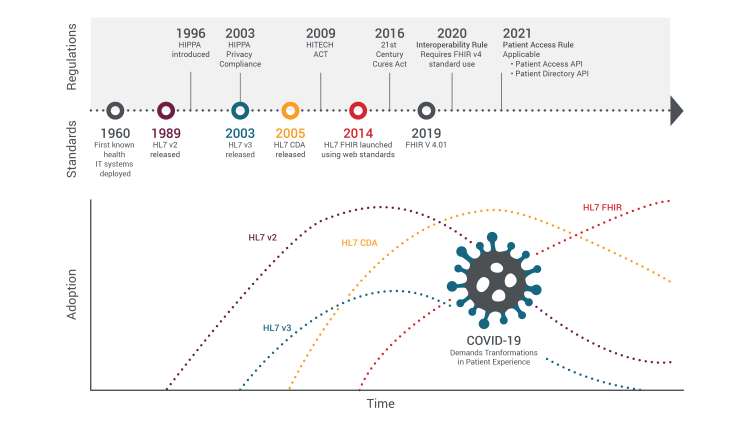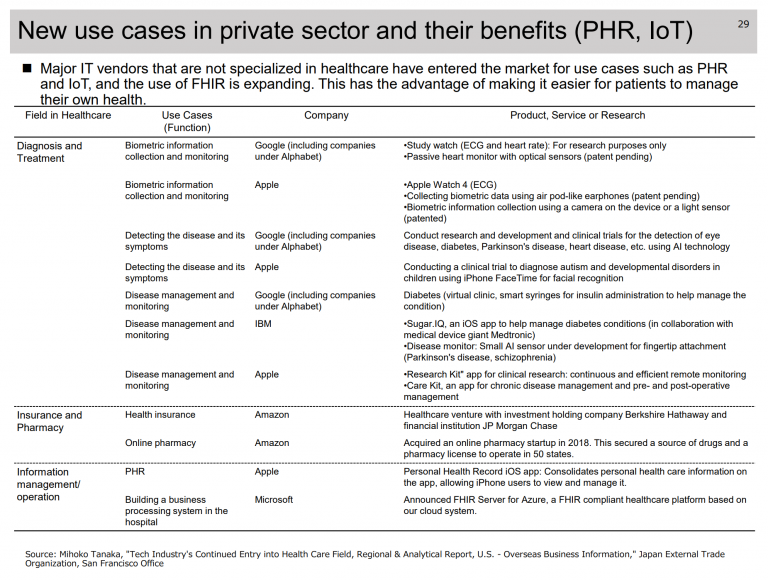
The rapid advancement of technology in the healthcare industry has highlighted the critical need for seamless data exchange and interoperability between various systems. Health Level Seven International (HL7) has played a significant role in enabling healthcare organizations to share vital patient information, driving improvements in patient care and overall healthcare efficiency. As the industry evolves, it is essential for healthcare providers to stay up-to-date with the latest developments in data exchange standards and technologies.
This article aims to explore the current trends in HL7 usage and provide an in-depth look into the future landscape of healthcare data exchange. We will discuss how older HL7 standards, such as HL7 v2.x and HL7 v3, are becoming increasingly outdated in the face of emerging technologies and data exchange requirements. In particular, we will highlight the potential of new standards like Fast Healthcare Interoperability Resources (FHIR) in transforming the healthcare industry’s approach to data exchange and interoperability.
By examining the shift from traditional HL7 standards to innovative alternatives like FHIR, this article will help healthcare professionals understand the evolving landscape of healthcare data exchange and prepare for the challenges and opportunities that lie ahead. As the healthcare industry becomes increasingly digital and interconnected, staying informed on these trends is essential for healthcare providers looking to optimize their data exchange processes and ultimately deliver better patient care.
The current state of HL7
HL7 messaging standards have been at the forefront of enabling healthcare data exchange and interoperability for several decades. As healthcare systems have evolved and become more complex, so have the HL7 standards. The most widely adopted versions, HL7 v2.x and v3, have played a pivotal role in facilitating communication between various healthcare systems and applications. Despite their widespread use, these older HL7 standards are now facing challenges due to their limitations in addressing the ever-changing landscape of healthcare data exchange.
HL7 v2.x, with its flexible structure and ability to accommodate various healthcare workflows, quickly gained popularity among healthcare organizations. Its primary advantage lies in the use of simple text-based messages that can be easily parsed and processed by different systems. This ease of use made it the go-to choice for many healthcare providers. However, the very flexibility that made v2.x popular has also led to inconsistencies in implementations, making it difficult to achieve true interoperability.
HL7 v3 was developed to address the shortcomings of the v2.x standard by introducing a more structured approach to messaging. It leverages XML-based messages and a formalized information model known as the Reference Information Model (RIM) to ensure greater consistency across implementations. Despite its advantages in promoting interoperability, HL7 v3 has faced adoption challenges due to its complexity and steep learning curve for healthcare organizations.

While HL7 v2.x and v3 have served the healthcare industry well for many years, the rise of new technologies and the need for more efficient data exchange have pushed the industry to seek more advanced solutions.
This is where FHIR comes into the picture. As a modern, web-based standard, it is designed to address the limitations of its predecessors by incorporating the latest advancements in data exchange, such as RESTful APIs and JSON-based messages. FHIR’s ability to enable seamless integration with modern web technologies has made it an attractive option for healthcare organizations looking to future-proof their data exchange capabilities.
Emerging trends in HL7 usage
The emerging trends in HL7 usage revolve around the growing adoption of FHIR, the rise of APIs, and the increased focus on data security and patient privacy. These trends signify a shift towards more modern, efficient, and secure data exchange solutions in the healthcare industry, demonstrating the need for healthcare organizations to embrace new standards to stay ahead of the curve.
Growing adoption of FHIR
As the healthcare industry continues to evolve, the limitations of older HL7 standards have become more apparent, prompting organizations to look for innovative solutions to improve interoperability and data exchange. One significant trend in HL7 usage is the growing adoption of FHIR as a means to overcome the challenges posed by legacy standards such as HL7 v2.x and v3. FHIR offers greater ease of implementation, compatibility with modern web technologies, and improved data representation.
Increased focus on data security and patient privacy
There has been an increased focus on data security and patient privacy in the healthcare industry, driven by stringent regulatory requirements and the growing threat of cyber attacks. As a result, HL7 messaging standards, including FHIR, are being adapted to incorporate enhanced security measures and privacy controls. For instance, FHIR incorporates granular access controls and robust authentication mechanisms, allowing healthcare organizations to safeguard sensitive patient data while maintaining efficient data exchange processes.
Rise of APIs in healthcare data exchange
Another emerging trend in HL7 usage is the rise of APIs (Application Programming Interfaces) to facilitate seamless data exchange between healthcare applications. APIs enable healthcare systems to interact with one another more efficiently, without the need for complex message parsing and processing. With FHIR’s inherent support for RESTful APIs, healthcare organizations can rapidly develop and deploy interoperable solutions that leverage the power of modern web technologies.
This has led to a surge in the development of FHIR-based APIs and applications, showcasing the standard’s potential in revolutionizing healthcare data exchange and fostering innovation, with more applications expected to emerge as FHIR adoption continues to grow. Notable examples include:
Apple Health Records: integrates FHIR to allow iPhone users to securely access their electronic health records from multiple providers.
SMART on FHIR: an open-source project that enables developers to create healthcare applications that can be easily integrated into existing EHR systems, enhancing clinical decision support and streamlining workflows.
Sync for Science (S4S): a collaborative project initiated by the NIH and ONC to enable individuals to contribute their health data to scientific research easily and securely.
Epic’s App Orchard, a marketplace for third-party applications that integrate with Epic’s EHR systems using FHIR-based APIs.
The impact of new technologies on HL7
The impact of new technologies like artificial intelligence, machine learning, and big data analytics on the future of HL7 and healthcare data exchange is significant. As these technologies become increasingly integral to healthcare operations, the need for efficient, flexible, and secure data exchange standards like FHIR will continue to grow. By embracing modern standards, healthcare organizations can ensure they are well-equipped to leverage the power of these emerging technologies and stay at the forefront of healthcare innovation.

Artificial intelligence and machine learning
The integration of artificial intelligence (AI) and machine learning (ML) technologies into healthcare systems has the potential to revolutionize the way healthcare data is exchanged, processed, and utilized. By leveraging AI and ML, healthcare organizations can automate the analysis of vast amounts of data, enabling more accurate and efficient decision-making. Consequently, the need for faster and more efficient data exchange standards like FHIR becomes more apparent, as these new technologies depend on seamless access to high-quality, standardized data.
Big data analytics
The emergence of big data analytics in healthcare has further emphasized the importance of efficient data exchange and interoperability. Healthcare organizations are now leveraging big data to derive valuable insights, improve patient outcomes, and optimize operational efficiency. To achieve these goals, there is a growing need for healthcare data exchange standards that can handle large volumes of diverse data, while ensuring data quality and consistency. The flexibility and scalability of FHIR make it well-suited to accommodate the demands of big data analytics, as it can effectively manage complex data sets and support real-time data exchange.
The convergence of technologies
As healthcare organizations continue to adopt and integrate AI, ML, and big data analytics into their workflows, the future of HL7 and healthcare data exchange will increasingly rely on the ability of these technologies to work seamlessly together. FHIR, with its modern architecture and support for diverse data formats, has the potential to act as a unifying force, bridging the gap between these cutting-edge technologies and the healthcare data they rely on. By doing so, FHIR can help unlock the full potential of AI, ML, and big data analytics in healthcare, driving innovation and enabling more effective, personalized patient care.
The future of healthcare data exchange
The future landscape of healthcare data exchange will likely be shaped by the adoption of latest standards and the integration of new technologies, leading to greater interoperability and efficiency in the industry. However, healthcare organizations must be prepared to tackle the challenges that come with adapting to these new standards and technologies. By fostering collaboration and maintaining a proactive approach, they can successfully navigate the evolving healthcare data exchange landscape and ultimately enhance patient care.
Challenges in adapting to new technologies and standards
While the potential benefits of adopting HL7’s latest standards are immense, healthcare organizations may face several challenges in adapting to these new technologies and standards. One challenge lies in the integration of legacy systems, which may still be utilizing older HL7 standards like v2.x or v3. Healthcare organizations will need to invest in the necessary infrastructure, resources, and training to support a smooth transition to the latest standards, such as FHIR.
Another challenge stems from the rapidly evolving nature of the healthcare technology landscape. As new technologies and innovations continue to emerge, healthcare organizations must remain agile and responsive to ensure they stay ahead of the curve. This may involve continuous assessment and optimization of their data exchange processes, as well as collaborating with other industry stakeholders to drive further standardization and interoperability.
Greater interoperability
As the healthcare industry continues to evolve and embrace new technologies, the need for greater interoperability becomes even more critical. HL7 FHIR’s flexible and modular structure, combined with its support for modern web technologies like RESTful APIs, will enable healthcare organizations to build more robust and interoperable systems. This will allow them to efficiently share data both within and across organizations, facilitating more seamless care coordination and improved patient outcomes.
Conclusion
The future of healthcare data exchange is set to be shaped by evolving HL7 standards, advanced technologies, and the growing need for interoperability. As healthcare organizations seek to adapt to this rapidly changing landscape, it is crucial to stay on top of the latest developments and trends. Staying ahead of the curve will enable organizations to capitalize on the opportunities presented by these advancements, leading to more efficient data exchange, streamlined workflows, and ultimately, enhanced patient care.
Partnering with experienced HL7 consultants like Itirra can prove invaluable in navigating the complexities of healthcare data exchange. With deep industry knowledge and expertise in the latest HL7 standards and technologies, Itirra is well-equipped to help healthcare organizations assess their current systems, optimize workflows, and implement future-proof data exchange solutions. By leveraging the expertise of HL7 consultants, healthcare organizations can ensure that they remain agile and responsive to the ever-evolving healthcare landscape.

